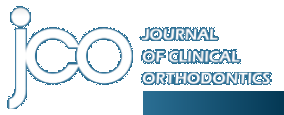Search Results For: 'orthodontics'
3401.
PEARLS
A Debonding Memento for Patients
Volume 34 : Number 8 : Page 469 : Aug 2000
Debonding day is a special day for any patient. Many orthodontists present their patients with mementos such as before-and-after photographs or models, but the appliances themselves are generally di...
3402.
The G-Spring: A Bondable Uprighting Spring for Self-Ligating Brackets
Volume 42 : Number 2 : Page 98 : Feb 2008
The introduction of interactive self-ligating brackets has offered orthodontists new mechanical options. Unfortunately, these brackets do not have vertical slots for the insertion of uprighting spring...
3403.
TECHNIQUE CLINIC
Transarch Stabilizing Wire for Essix Retainers
Volume 44 : Number 8 : Page 498 : Aug 2010
Essix removable retainers are gaining popularity among orthodontists, thanks to their ability to encapsulate and retain both posterior and anterior teeth.1 Because of their minimal thickness and "U"-s...
3404.
MANAGEMENT & MARKETING
Practice Acquisition: Financing and Related Issues
Volume 37 : Number 9 : Page 485 : Sep 2003
This is our third column within the past few years dealing with the subject of buying a practice. In all three, the basic message has been the same: thorough evaluation and planning, with professional...
3405.
MANAGEMENT & MARKETING
Strategic Financial Statements for Better Practice Management
Volume 48 : Number 11 : Page 703 : Nov 2014
Industry-standardized financial statements can offer benchmarks for comparison to your colleagues, provide ongoing financial information for managing your practice, organize your expenses for review ...
3406.
THE READERS' CORNER
Volume 56 : Number 2 : Page 121 : Feb 2022
JCO readers describe the procedures they use for cosmetic finishing. A wide range of finishing products are listed, including disc, burs, composites, and whitening gels. Considerations for younger patients, the effectiveness of aligner therapy, and periodontal issues are also discussed.
3407.
Practice Acquisition: Financing and Related Issues
Volume 37 : Number 9 : Page 485 : Aug 2003
Originally published in September 2003 This is our third column within the past few years dealing with the subject of buying a practice. In all three, the basic message has been the same: thorough eva...
3408.
Strategic Financial Statements for Better Practice Management
Volume 48 : Number 11 : Page 703 : Aug 2014
Originally published in November 2014 This column is compiled by JCO Contributing Editor Robert S. Haeger, DDS, MS. Every few months, Dr. Haeger presents a successful approach or strategy for a partic...
3409.
Panoramic Surveys and the Missing Mesiodens
Volume 25 : Number 5 : Page 0 : May 1991
Most orthodontists routinely use only a panoramic x-ray, rather than a full series, for diagnosis.1 Panoramic surveys are the fastest and safest way to see all the teeth, especially those that are not...
3410.
BOOK REVIEWS
3D Imaging and Dentistry: From Multiplanar Cephalometry to Guided Navigation in Implantology
Volume 56 : Number 2 : Page 127 : Feb 2022
GIOVANNA PERROTTI, DMDTIZIANO TESTORI, MD, DDS, FICDMASSIMILIANO POLITI, DMD 560 pages, 1,277 illustrations. $98. 2016. Quintessence Publishing Co., Inc., 411 N. Raddant Road, Batavia, IL 60510.(800) ...
3411.
Volume 27 : Number 6 : Page 0 : Jun 1993
Topics include slot sizes, full vs. segmented arches, and use of loops; and inventory methods. 1. What slot size do you typically use? Fifty-seven percent of the clinicians reported using an .018"X.02...
3412.
Innovations in Orthognathic Splint Construction
Volume 19 : Number 10 : Page 750 : Oct 1985
This technique is a refinement of current methods of orthognathic splint construction. Presurgical Records After preliminary orthodontic leveling, alignment and arch coordination, a clinical examinati...
3413.
Volume 22 : Number 11 : Page 0 : Nov 1988
The in-office Computer-Aided Diagnosis and Treatment Planning System (CADIAS) interrelates patient information, cephalometric analyses, and cast mountings on a fully adjustable articulator to produce ...
3414.
Unstable Occlusion and Temporomandibular Joint Disease
Volume 23 : Number 5 : Page 0 : May 1989
The relationship between occlusion and the TMJ has been the subject of considerable controversy.1-9 Many cases of unstable occlusion have been poorly understood and difficult to correct because of TMJ...
3415.
Clinical Use of Silicone Elastomer Appliances
Volume 23 : Number 10 : Page 0 : Oct 1989
Kesling introduced the tooth positioner for artistic finishing in 1945,1 and proposed a series of positioners for graduated movement toward a corrected occlusion in 1946.2 Because these positioners we...
3416.
Two-Archwire Technique for Alignment of Impacted Teeth
Volume 31 : Number 3 : Page 183 : Mar 1997
Although the ideal treatment for impactions is preventive, a number of surgical and orthodontic techniques are available for aligning impacted teeth when necessary.1-10 The introduction of superelasti...
3417.
THE CUTTING EDGE
How I Use the Internet in My Office
Volume 36 : Number 8 : Page 447 : Aug 2002
In this month's column, Dr. Robert Haeger describes state-of-the-art Internet usage for the benefit of patients, staff, and clinician in his orthodontic office. He has assembled an impressive array of...
3418.
Reduction of Gingival Display with Maxillary Intrusion Using Endosseous Dental Implants
Volume 42 : Number 3 : Page 157 : Mar 2008
Excessive gingival display is an unattractive smile characteristic with multiple etiologies. Vertical maxillary excess, supraeruption of the maxillary incisors, and shortness or hypermobility of the u...
3419.
CASE REPORT
Treatment of an Unusual Crossbite with an Impacted Mandibular Second Premolar
Volume 42 : Number 6 : Page 341 : Jun 2008
A 14-year-old female presented with the chief complaints of retroclined upper front teeth and dissatisfaction with her smile (Fig. 1). Clinical examination revealed a Class I molar relationship with s...
3420.
Early Treatment of Pseudo-Class III Malocclusion: A 10-Year Follow-Up Study
Volume 43 : Number 11 : Page 0 : Nov 2009
[Figures 3 and 4 and Appendix Tables 2, 3, and 4 were corrected by the authors in August 2011. Correction published in JCO, August 2011. PDF version of the article includes complete corrected figures ...
Showing 3401-3420 of 4092 results. Search completed in 0.083 seconds.

